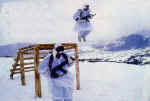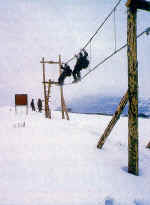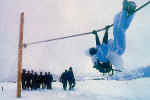Units
High-Altitude Warfare School
- Details
- Created: 12 October 2006
- Written by N A Gokhale
- Hits: 18418
|
By N.A. Gokhale in Pemgarh, Arunachal Pradesh © Outlook India - 03 April 2000 |
|||
|
It's surprising for a country that has the world's fourth largest army and also a long, sensitive border along the world's highest mountain range. Yet, the fact is it took something on the scale of Kargil before the need to have troops trained for high-altitude combat dawned on everyone. At Kargil, the paucity of battalions specialised in mountain warfare meant India started with a severe handicap. That chastening experience has now borne fruit: in the shape of the high-altitude commando school at Tawang, Arunachal Pradesh. Set up in double quick time, the Parvat Ghatak School or the High-Altitude Commando School is the highest of its kind in the world at 15,000 feet. With the mercury dipping to minus 20 degrees, the army could not have chosen a tougher terrain to impart training. Here, only the toughest can survive. Any kind of movement for the uninitiated is laborious-breathing is an exercise in itself. Traversing in two-and-a-half feet of snow by foot is next to impossible. It is here, at Pemgarh, barely 2 km from the India-China border, that troops get a feel of what it might be like in a real combat situation in theatres like Kargil. The school has been established and is run by the Tawang-based Korea brigade (so called for having taken part in the US peace-keeping mission there in the 1950s) under the Tezpur-headquartered IV Corps. The course it runs is perhaps the most comprehensive one that the army could have asked for. Says IV Corps Commander, Lt. Gen. D.B. Shekatkar, "The Parvat Ghatak school combines the best elements of the Commando Training School in Belgaum, Karnataka, and the High-Altitude Warfare School at Sonamarg, near Srinagar. Those who come here are trained in both commando tactics and ways to survive high altitudes." |
|||
|
|||
|
The fact that the course is only for those in peak physical condition goes without saying. Officers and men of a Maratha Light Infantry unit which had the benefit of the four-week course will testify to this. Says its commanding officer, Colonel Ashok Ambre, "The course is designed only for those who are extremely fit and have an aptitude for commando tactics." Indeed, each batch of troops which trains at the school is of platoon strength and each man is handpicked before being sent to Pemgarh. The composition of each platoon is one officer, a junior commissioned officer (JCO) and 26 other ranks. Each platoon has to undergo a four-week training capsule specially designed to toughen the troops and prepare them to take on the most challenging assignments. "This platoon is trained to go behind enemy lines, carry out subversive acts, commando raids and survive all adversities," says Colonel Ambre. Major Paramjit Singh, who has trained at both the Belgaum and Sonamarg schools, was assigned the task of designing the course, its content and the training schedule. "The challenge was in combining the toughest elements of both the courses. As a commando, one is trained to be quick and accurate but as a commando in the inhospitable mountains, we have to have both the precision and stamina to overcome the adverse elements." Trainees who are assigned to undergo the four-week course here actually begin their preparations much earlier. For example, all of them, as indeed each army man posted here in the Kameng sector, have to follow the acclimatisation schedule. The first halt of six days is at an altitude of 9000 feet. During these six days, troops are advised to rest on the first two days, followed by short walks on the next two. In the final two days, jawans and officers alike are supposed to walk at least 5 km. The next halt is at 12,000 feet. A similar but shortened routine is followed at this height. Once this is done, soldiers are ready to be at heights above 15,000 feet. |
|||
|
|||
|
In fact, in the Kameng sector-which has a border frontage of more than 270 km with China-some vital posts are located at altitudes of over 20,000 feet. Says Brigadier V.D.I. Devavaram, commander of the Tawang-based Brigade, "Some of our posts are approachable only by air but come winter or rain, our boys are always up there." The Korea brigade is responsible for guarding the vital frontier with China. Therefore, all the battalions assigned to this brigade are given the first priority when it comes to training at the Ghatak platoon. The course itself is divided into four sections. The four main sections in the training are toughening exercises, an assault course, rock craft and sharp-shooting. But prior to this there is a special acclimatisation programme. Explains Major Paramjit: "Without proper acclimatisation and requisite physical strength, no one can last this course beyond a week." During the first week, the earlier part of the day is devoted to sheer physical exercise where trainees walk long distances, progress to a bit of jogging and then running. In the latter half, theory classes on various technical matters such as laying IEDs (improvised explosive devices), setting ambushes and honing direction finding skills with a compass are taught and other arts developed. Next comes the completion of the assault course with its numerous obstacles like Lion Jump, Monkey Rope, Leopard Curve, Ghatak Crawl and Burma Bridge. Each of these obstacles is designed to test various aspects of a man's physical and mental strength. In the Ghatak Crawl, for instance, soldiers have to go under a barbed wire for a minimum of 50 metres, carrying all the equipment they usually do, without straightening up. Burma Bridge, so named because it resembles the kind used in Burmese jungles during World War II, is a single rope with two more forming a kind of railing on either side. This 100-metre walk, usually built over a stream, is one of the toughest courses since the soldier has to not only maintain his balance but also walk across quickly even as he is loaded with all the assault equipment. |
|||
|
|||



